The Most Spoken Languages in American Neighborhoods (Besides English and Spanish)

What language does your family speak around the dinner table?
While 78% of Americans only speak English at home, you may not know that it’s not an official language in the U.S. in the same way French is in France or Portuguese is in Brazil. English may be America’s de facto language (as the most commonly spoken), but millions of households across the U.S. use another language entirely.
In total, between 350 and 430 languages can be found in the States. After English, Spanish is the next most common, spoken by 62% of non-English speaking households — but what other languages might you hear from house to house in the U.S.? To find out, WordFinderX used Census data to discover the most spoken tongues (other than English and Spanish) across American neighborhoods.
What We Did
Within each U.S. state, major city and district of New York City, we used U.S. Census Bureau data to discover the prevalent language used in local households apart from English and Spanish.
Key Findings
- German is the most spoken language (outside of English and Spanish) in 13 states — more than any other language
- Tagalog is the most spoken language in nine cities in the Western U.S.
- Chinese, Vietnamese and Arabic are the most spoken in major Southwest cities
- Chinese and Russian are spoken widely across New York neighborhoods
German Is the Most Spoken Language in 13 States
English might be the most common language in the U.S. But the official tongue was very nearly German — at least, so goes the myth of Frederick Muhlenberg, the first ever Speaker of the House of Representatives, whose one vote prevented German from becoming an official language of the U.S. back in the 1700s. Nowadays, outside of English and Spanish, German is the most widely spoken language in 13 states, outnumbering any other tongue, including French and Chinese.
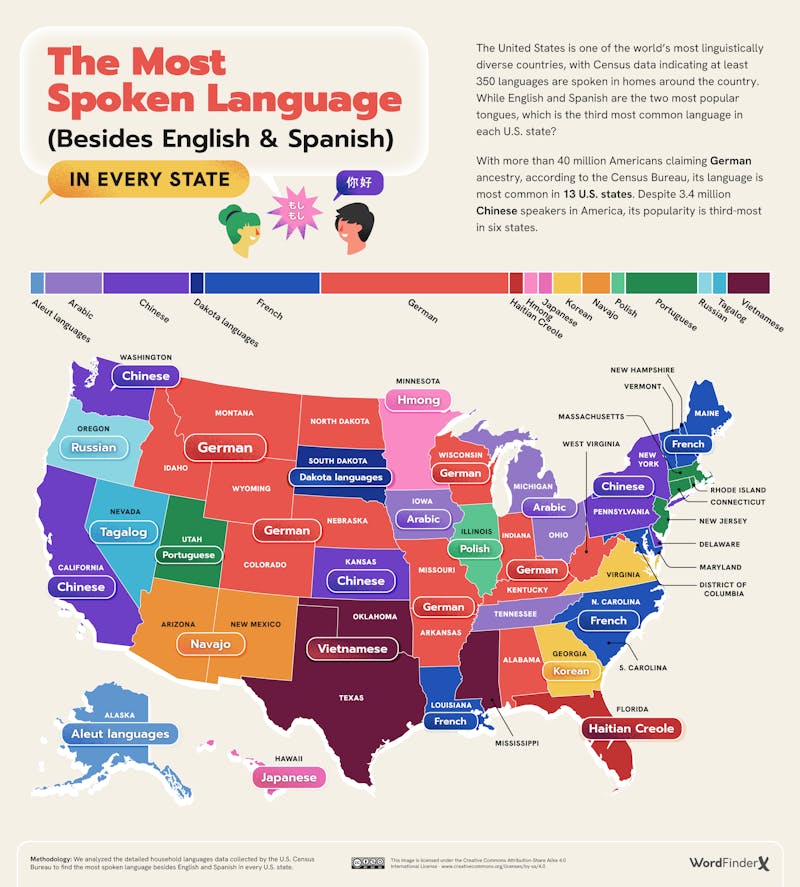
Two of these states (North Dakota and Wisconsin) are notches on the country’s “German belt,” areas of the U.S. where German immigrants historically settled. Wisconsin, in particular, counts the largest proportion of residents who identify as German.
Tagalog Is Spoken Widely in the West
America’s West is home to nearly half (45%) of all U.S. Asians, so it checks out that certain Asian languages are the most spoken tongues (after English and Spanish) in major regional cities. Tagalog (one of the main languages of the Philippines) is the most spoken language in nine cities, spanning from Anchorage in Alaska, where half of the local Asian community is Filipino, down to Las Vegas, Nevada, home to one of the largest Filipino-American communities in the country.

Meanwhile, Vietnamese and Chinese are the most common languages (outside of English and Spanish) in four cities apiece. Two cities where Chinese is popularly spoken (San Francisco and Seattle) boast significant Chinese-American communities as a result of immigration.
Vietnamese Is a Common Language in the Southwest
In five Southwestern cities, Vietnamese ranks as the most common tongue outside of English and Spanish. Three of these cities can be found in Texas, including Houston, where you’ll find the second-largest population of Vietnamese-Americans in the entire country. The U.S. has seen three major waves of Vietnamese immigration over the last fifty years, beginning in 1975 when the Fall of Saigon compelled thousands of mostly white-collar workers to leave their home country.
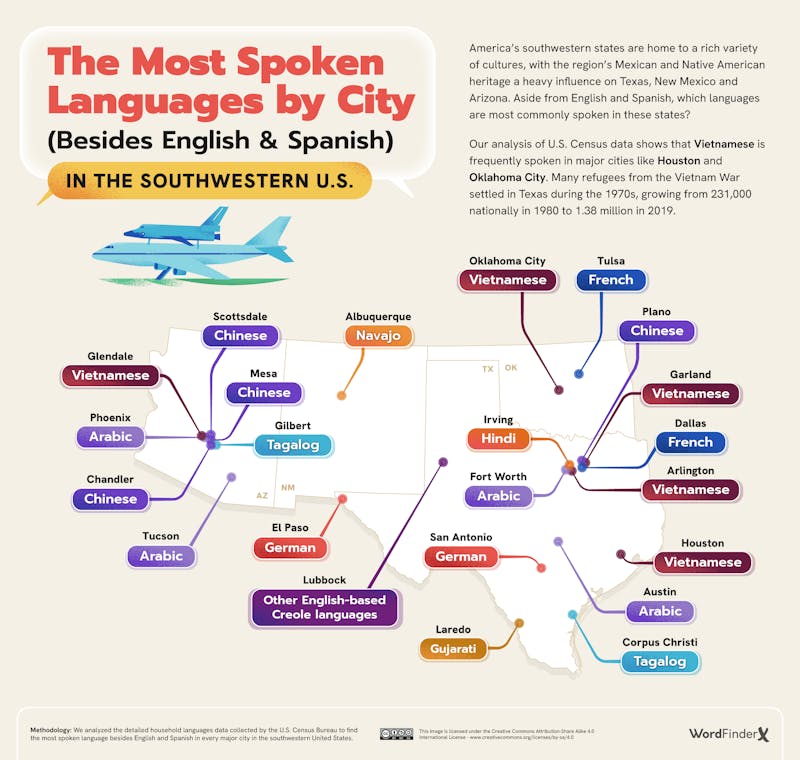
Other languages spoken the most in Southwest households include Arabic, Chinese, French and German. Over in Albuquerque, Navajo takes the top spot, a language used by the Navajo Nation tribe that lives on the largest reservation in the country, partially spread over New Mexico.
French Is Spoken the Most in Four Midwest Cities
From its assistance in the American Revolution to the Louisiana Purchase, France has played a huge role in the shaping of America, and today, close to 9.4 million people in the U.S. claim either French or French-Canadian ancestry. In the Midwest, French is the most spoken language (after English and Spanish) in four major cities, including Kansas City (MO). Among the rarest French dialects in the region is Missouri French (nicknamed “Pawpaw French” for the local trees), which only a handful of people still speak. For a word game enthusiast, try putting "femme" in a scrabble word finder, meaning wife, in "Pawpaw French."
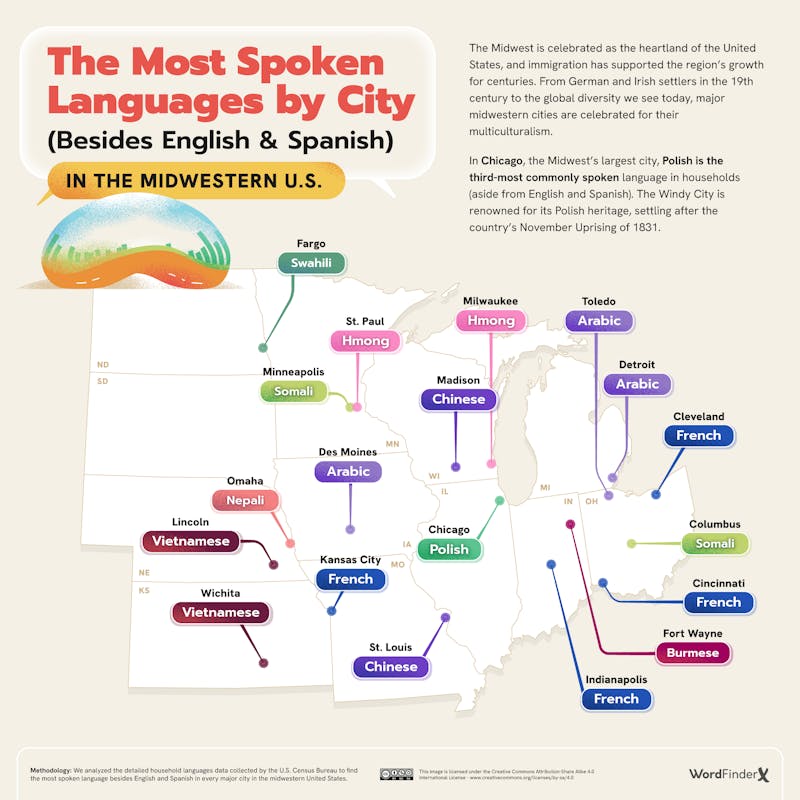
Across the Midwest’s major cities, the most spoken languages locally (aside from English and Spanish) range from Arabic and Swahili to Burmese and Nepali. Polish is the most spoken language in Chicago (IL), labeled America’s “traditional capital of the Polish diaspora” by Culture.pl.
Arabic and Haitian Creole Can Be Found in Major Southeast Cities
In the Southeast, Arabic is the most spoken language in six major cities, including two (Lexington and Louisville) in Kentucky. According to the YALLA COUNT ME IN movement, which aims to improve Arab American representation in the U.S. Census, Kentucky counts one of the fastest-growing Arab populations in the country. Arabic also comes top in two Tennessee cities, where advocates are working hard to get the language added as an option for driving tests.
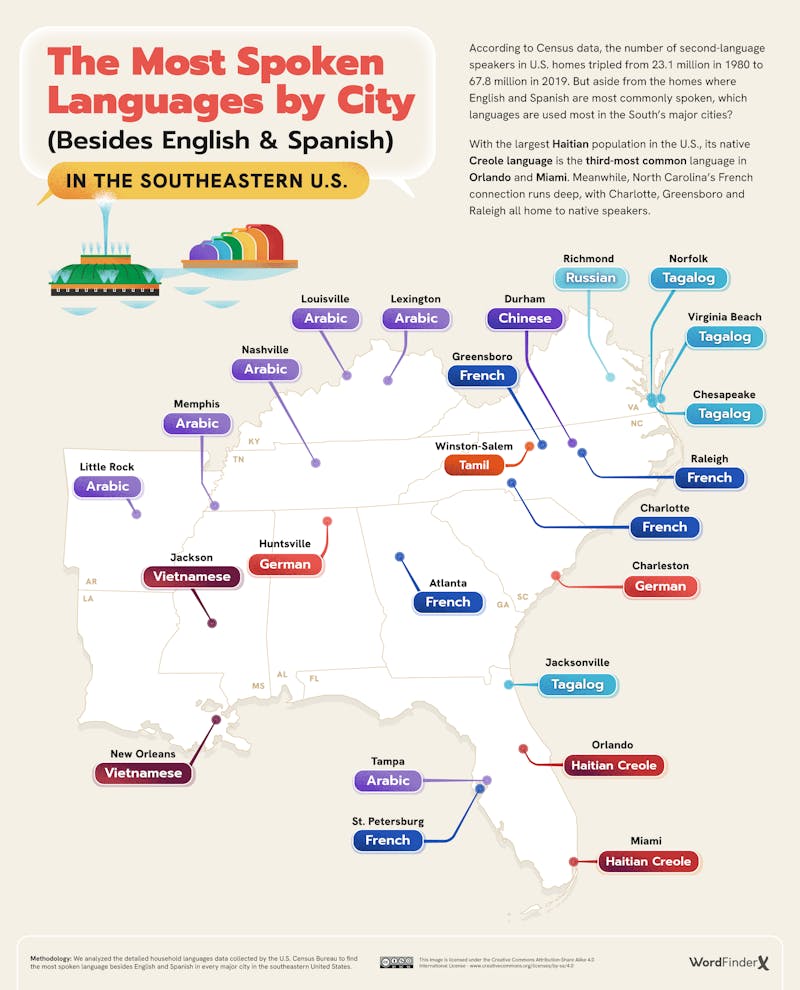
Haitian Creole is the most spoken language in two Florida cities (Miami and Orlando), the state home to the largest population of Haitians. Tens of thousands of Haitian immigrants settled in Florida — some 800 miles away from Haiti — following the country’s devastating 2010 earthquake.
Hindi and Bengali Among Languages Spoken at Home in the Northeast
Haitian Creole is also the most spoken language in the Northeast cities of Bridgeport (CT), Providence (RI) and Boston (MA), the latter of which saw the first wave of Haitians settle in the 1950s and 1960s. Bengali comes top in Buffalo, where the Partnership for the Public Good (PPG) writes that “Bangladeshi immigrants have relocated … at a pace that has surprised many.” According to the PPG, factors include the high cost of living in New York City and Buffalo’s network of ten mosques.
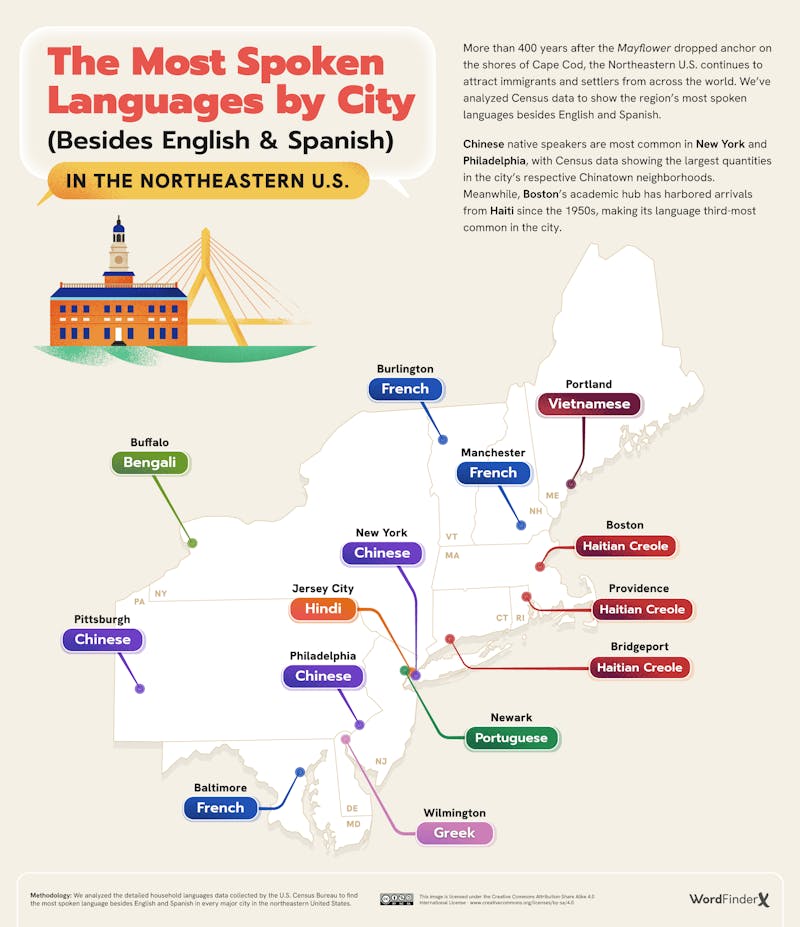
Hindi comes top in Jersey City (NJ), where you’ll find India Square, home to one of the Western hemisphere’s largest concentrations of Indian people. Meanwhile, French is the most spoken language (outside of English and Spanish) in Baltimore (MD), Manchester (NH) and Burlington (VT).
Chinese and Russian Is Spoken Widely in New York City
New York City has historically been a significant gateway for millions of people looking to start a new life in America. As such, the city today boasts an eclectic mix of cultures — but after English and Spanish, which languages are the most spoken across the city? Chinese ranks as the most spoken language in 15 neighborhoods — more than any other language — including Manhattan’s Chinatown, home to the largest population of Chinese people in the Western Hemisphere.
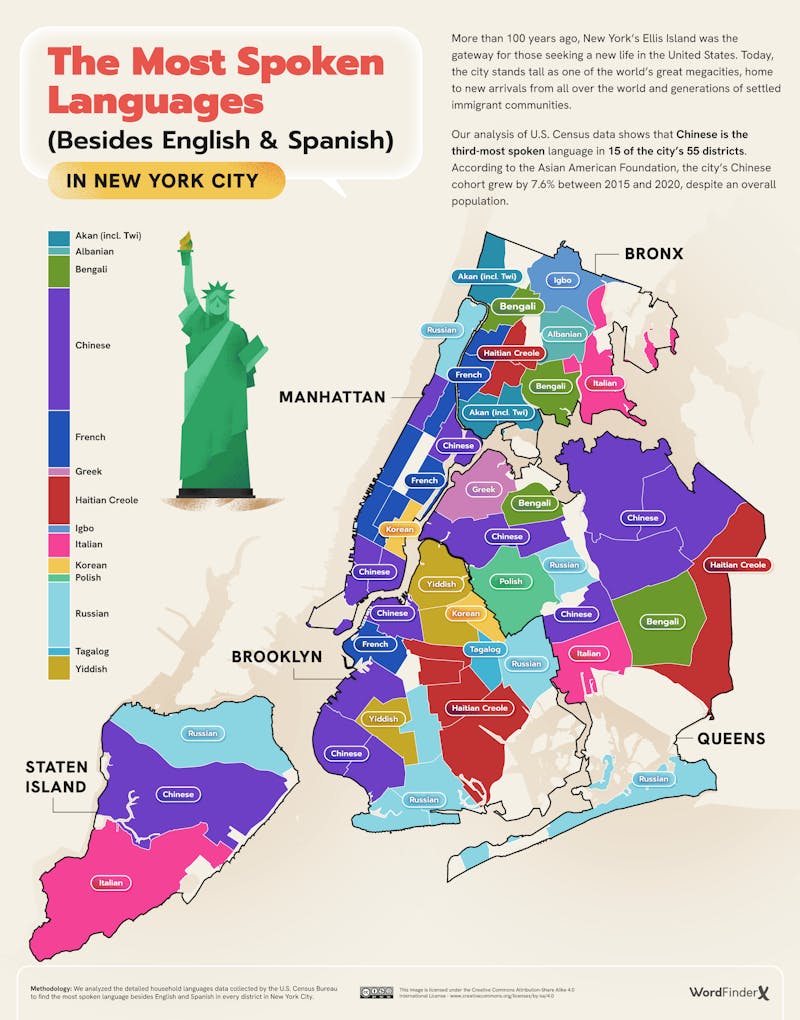
Russian takes the top spot in eight other neighborhoods, including Brighton Beach, which in the late sixties saw an influx of Soviet and Ukrainian immigrants for whom the area was reminiscent of the city of Odesa by the Black Sea. Italian is the top language in three other neighborhoods, including Howard Beach, where half of the population is either Italian or claims Italian ancestry.
Language Hotspots Across the U.S.
Where in the U.S. are languages more likely to be spoken than anywhere else? Based on U.S. Census Bureau data, our chart reveals the top states for specific languages, ranked by the percentage of households that speak that language at home.
Chinese, for example, is spoken by 1.89% of households in California; it might seem like a small percentage, but it’s greater than any other U.S. state. Italian is spoken the most in Connecticut households (1.01%), where one-third of residents claim part or exclusive Italian ancestry.
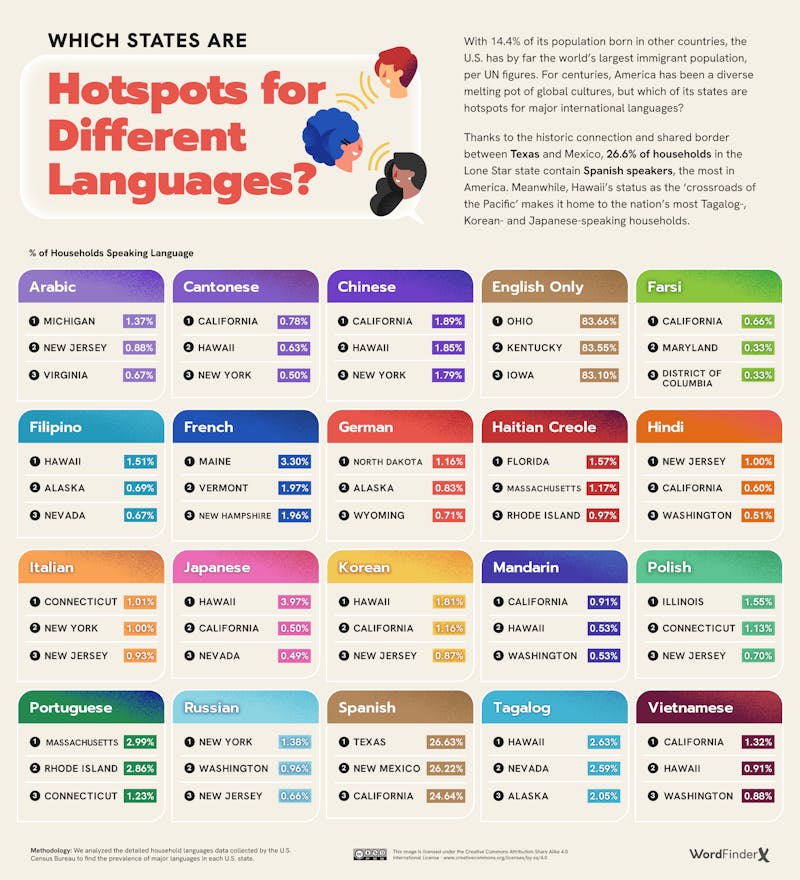
While many languages across America are thriving (Spanish, for example, is projected to count 138 million speakers in the U.S. by 2050), some are on the verge of extinction. These include rare regional dialects, like the aforementioned Pawpaw French in Minnesota, and indigenous languages that count just a handful of speakers, like the critically endangered Arikara language of the Arikara Native American tribe in North Dakota.
The good news is that work is being done all across the country to keep endangered languages alive. One example is the Caddo language of the Caddo Nation of Oklahoma, which — after losing five of its seven remaining fluent speakers during the COVID-19 pandemic — is now being passed onto children in a new childcare program. Technology is also on hand to help out, with various apps on the market designed to preserve and educate people about endangered tongues the world over through seamless interactive gadgets. From word finder tools and language quizzes to virtual conversation partners and pronunciation guides, the array of available resources caters to diverse language learners.
How We Did It
We analyzed the "detailed household languages" data by state, city and NYC districts from the U.S. Census Bureau, specifically the "ACS 1-Year Estimates Public Use Microdata Sample" and the state equivalent. Within each U.S. state, major city and district of NYC, we specifically chose the most prevalent household language apart from English and Spanish.
The U.S. Census Bureau defines “detailed household language” as the language assigned to the household based on the non-English language reported by those living in the household. If it is a single-person household, the household language is the language reported for that person. If there is more than one language spoken in the household, the household language is assigned in the following order (based on the relationship to the reference person) — (1) reference person, (2) husband/wife, (3) son/daughter, (4) brother/sister, (5) father/mother, (6) grandchild, (7) in-law, (8) other relative and (9) other non-related household members.
The data collection took place in May 2023. This analysis is correct as of July 2023.